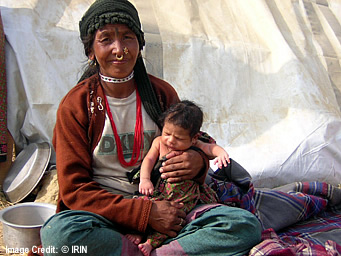Hundreds of thousands of people displaced from their homes during the decade-long war between Maoist rebels and the government are having difficulty returning to their homes, despite the conflict ending in November 2006, aid workers say. Last year, the Nepalese government estimated that there were more than 200,000 internally displaced people (IDPs) in the country but there is no accurate information on whether that number has reduced after peace was achieved five months ago.
"There
are issues of local Maoists not adhering to commitments made in the peace
agreement," Paul Handley, humanitarian affairs officer with the UN's Office
of the Coordination for Humanitarian Affairs (OCHA) in Nepal, told IRIN
in the capital, Kathmandu.
It is no longer the threat of physical security but more of food and land security that has been impeding returns, said aid workers. "I have nothing to eat or survive on. So how can I return home? Just to starve myself?" asked Ramesh Biswakarma in Kathmandu, where he is living in poverty after he fled from his remote village in the northwestern Jajarkot district. A large group of displaced people from Jajarkot is still living at an IDP camp in the Rajhena area of Nepalgunj city, 600 km west of the capital. Camp residents are desperately seeking help from aid agencies to ensure their protection, safety and the return of their properties. "Land continues to be a problem in rural areas with IDPs not being able to access their lands," Aidan Goldsmith, director of International Rescue Committee (IRC) in Nepal, told IRIN. I
have nothing to eat or survive on. So how can I return home? Just to starve
myself?
IRC has been working in the country for the past two years with a focus on IDPs, other conflict-resolution issues and health projects. "There
is a prime need for assisting the IDPs to restart their lives and help
them to become functioning members of the community," said Goldsmith.
A new policy for assisting the displaced, formulated and passed by the Nepalese parliament three weeks ago, is seen as key to resolving the displaced persons issue. "It's a good policy and critical towards assisting the IDPs," Alexander Jones, Nepal's country director of the Norwegian Refugee Council (NRC), said. In addition to OCHA, other key UN agencies and IRC, the NRC was also part of the task force to help the government develop the new IDP policy. Jones said that according to the new policy, citizens forced to leave their homes will have the right to protection from the state. The policy also helps to clearly define the status of an IDP, which was not the case before. NRC, which provides legal assistance to the displaced in more than 10 countries, also launched an Information Counseling and legal Assistance project a month ago in Nepal. Since then, many displaced families have been able to get advice on their legal rights and access to justice as well as guidance on legal documents which would give them access to their properties. However, Jones said that many IDP families lost their land and property legal documents after they were forced to leave their homes. At present, many of them lack enough Document to even get any compensation from the government for their lost properties.
Copyright © UN Office for the Coordination of Humanitarian Affairs 2006 [ This report does not necessarily reflect the views of the United Nations] Integrated Regional Information Networks (IRIN), part of the UN Office for the Coordination of Humanitarian Affairs (OCHA).
|







